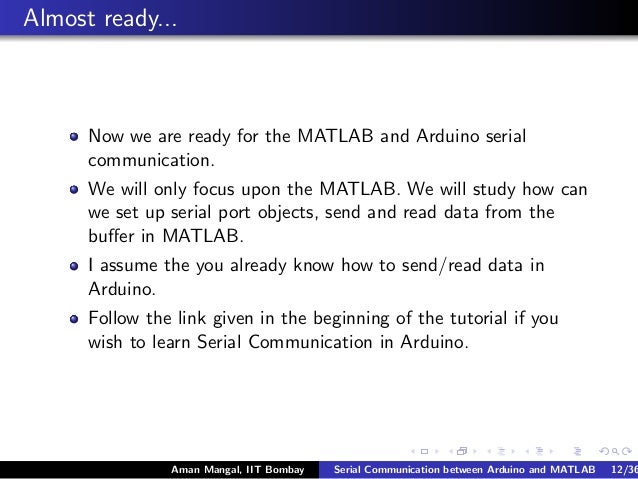Matlab And Arduino Serial Communication Speed


Serial Communication data retrieval is too slow?? Learn more about serial communication, arduino. It gets stored in the input buffer of MATLAB in 15 mins. Arduino serial communication with Matlab (DAQ. Cod4 Promod 204 Music. Learn more about matlab arduino, arduino. Matlab code is as: doi = 3; arduino=serial. Sending values from Matlab to arduino using serial communication. Why does stall speed decrease when flaps are.
I am trying to acquire data from an Arduino MEGA board. The code which i used works fine for small duration (say 10s, 20s.).
But when i executed it for 15mins, it took 11hrs. Can i overcome this problem?? If t and a1 grows in each iteration until they have n elements, Matlab has to reserve sum(1:n) * 8 * 2 bytes. For n=1000 this is not a problem on modern computers, but what about n=1e5? Although the result is not really large, 80 GB must be allocated, copied and freed if you omit a pre-allocation. If the final size is not known and even an upper limit cannot be estimated, read in blocks of e.g. 10'000 characters (*with* pre-allocation) and store the blocks in a cell array.
If the pre-allocated size of the cell is exhausted, let it grow by 10'000 or another large number. You can join the blocks after the transmission is ready. Its a steady stream of decimal numbers (say 0 to 1023) separated by carriage controls. I dint get any problem with BytesAvailable because i read the data from the buffer till it is empty (And all the data is my data from ARDUINO).
If i send the data, say for 15 mins, it gets stored in the input buffer of MATLAB in 15 mins. But to retrieve it from the buffer, we use fscanf or fread etc., and this is taking a long time (in my case it took 11hrs). But my question is whether we can get the data as a whole from the input buffer (something like a txt file or an array)? Btw what do you mean by storing the characters for later?
You should try out the Teensy or Teensy++ from also available from Sparkfun. Paul uses an Atmel chip (ATmega32U4) onthe Teensy that is similar to the ATmega328 used on Arduino, but it has a built-in USB interface. Paul provides support for writing Arduino code on the Teensy with the “Teensyduino” add-on for the Arduino IDE. Arduino has a serial interface between the ATmega328 and the USB chip which limits data rates to ~1000 characters per second, as pointed out above. The Teensy supports 12Mbps over USB (“Fast USB”).Paul says that he sees serial throughput of over 1Mbps. I’ve gotten over 10K multi-character samples per second in a project comparable to your test using code I didn’t even try to optimize for speed using a Teensy.
But I’m using CoolTerm to read in the serial data and save to a file, and it doesn’t go up that high. What would you recommend to use to actually see and save the incoming data? Also, thanks for the hint on sending binary data with Serial.write – I had tried formatting the Serial.print with the BIN formatter, but I understand that has more overhead. But I’m curious how to get one analog read value with the two commands (lowByte and highByte) – I guess the analogRead number is 10 bits, so that fills the whole lowByte and 2 places of the highByte, correct?
Hello, I have learned a lot from this conversation. I am doing kind of smiler project. I used Arduino as hardware, and couple of sensor.
And I interfaced with MATLAB and Coolterm both. I want to plot sensor data using MATLAB in real time and store those data in a txt file through Coolterm. Windows Presentation Foundation 4.5 Cookbook.





